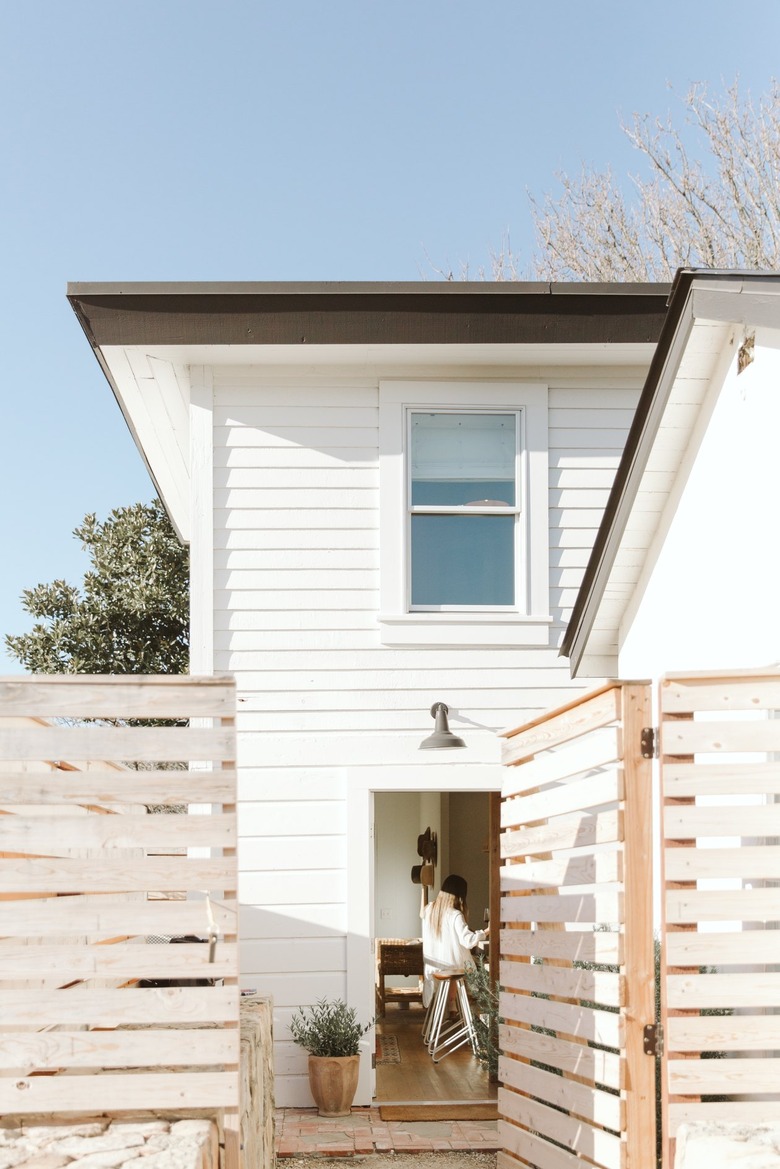Making Fence Plans And Preparing For Fence Installation
We may receive a commission on purchases made from links.
Do good fences make good neighbors? They might, and a fence certainly can add value to your home in many ways—as long as you begin the project with detailed fence plans. Even if you are planning a DIY fence, you need to walk through the important steps, including checking out the legalities (like whether building permits are needed), the practicalities (like property boundaries) and the type of fence that would work best for your situation.
Legal Issues of Fence Plans
Legal Issues of Fence Plans
Whether you've decided to build a fence to increase your home's curb appeal, to mark your property lines, to create more privacy or to keep pets in and critters out, you need to act within the applicable laws, whether state or local. According to FindLaw, fencing laws often limit the height of fences in both the front yard and backyard and may restrict the type of fence and the setback required as well. These can be state laws or city or county ordinances, but the height and style of fencing can also be restricted by property subdivision rules called covenants, conditions and restrictions. You may even need to apply for a permit.
Fence laws are certainly not uniform, so you need to get a copy of those that apply in your area and talk to your city building and zoning departments. Sometimes, height regulations will apply to hedge-type fencing made of a line of trees or shrubs. Some fencing laws forbid certain types of fences in certain areas — for example, chain-link fences in the front yard. Many ordinances contain exceptions that "grandfather in" fencing that was in place before the law was enacted, but some do not. If the regulations seem at odds with your fence plans, see if the governing authority offers the possibility of applying for a variance to the law.
Practical Issues of Fence Plans
Practical Issues of Fence Plans
Many property owners choose to put fencing near or on a property line — a placement that works well for privacy fences, for example. If that is the case, it is imperative for you to be certain about the exact location of the property line. This is not the time to guess or rely on your neighbors' thoughts on the subject since a mistake may be very expensive and even litigious. If your property is marked by metal property stakes and you feel comfortable finding the property stakes yourself with a metal detector, that can work. Otherwise, hire a surveyor to review your property mapping and advise you. If necessary, pay for a new survey.
Another practical step is to make sure your fence plans won't interfere with the local utilities. Installing fence posts requires digging. According to Common Ground Alliance, you should dial 811, the national "call before you dig" phone number, to have any buried utilities marked. This will prevent you or your contractor from unintentionally hitting an underground utility line. The service is free, but it can take several days to get all of the different lines marked by the various utility providers.
While talking with your neighbors about your fence plans is not a legal requirement, it's a good idea, according to Yard & Home. You may want to wait until you've decided on the style of the fence and the material you are going to use. This is especially important if your fence will be on the property line. If your fence plans include a fence with a good side and a bad side, it's polite to give the neighbors the good side, and in some places, it may be legally required.
Fence Design and Location
Fence Design and Location
Your fence design and location will depend in part on your reasons for fencing. Fence styles vary widely, and while a white picket fence may add curb appeal to your front yard, it won't double as a privacy fence. However, a fence can solve more than one problem. For example, a wooden privacy fence might block the neighbor's view and also serve to keep deer out of your backyard and to keep pets inside.
According to Family Handyman, if you are building a privacy fence, fence height is critical to ensuring privacy. Take into account whether neighbors have raised patios or balconies on a higher level. The slope of the land will also play a role.
It can be a good idea to make a cardboard screen cut to the proposed height of the fence. Have a helper walk the screen around the property as you keep your eye on the view above the cardboard. It's better to figure this out before you buy the fence panels and other fencing material. Also keep in mind that most cities and other authorities impose strict height limits on residential fences.
If your fence will pass over uneven ground, you also need to take this into account when you are considering design. According to Vinyl Fence Wholesaler, there are two simple ways to accommodate this. If the slope is mild, you can consider racking, where a fence follows the contours of the ground. A racked fence leaves almost no space between the bottom of the rail and the ground. For more pronounced slopes, consider a stepped fence. The sections are different heights, like stairs, and each has a triangular gap between the rail and the ground.
Once you've identified the purpose or purposes your fence will serve, get some graph paper and draw some fence plans. Remember that your fencing doesn't have to be all the same design, height or material. Make a few drafts until you feel comfortable that the location of the fence and its height will serve your purposes. It's foolish to begin this home improvement project without considering several different options. If you are using a contractor, she will be able to do this for you.
The locations of posts and gates should be included. Family Handyman recommends that the posts be no more than 8 feet apart to create a strong fence that won't sag. It's also important to include plenty of strong horizontal support rails. If you need a building permit to construct the fence, this type of sketch may be required as part of the application.
As you put together your fence plans, consider your budget for the project. Different fence materials can have dramatically different price tags. Budget is not the only consideration. Some materials last longer than others. If you are thinking of a wood fence, consider whether the wood is treated for protection against moisture and insects. You'll also want to take the style of your home and your neighborhood into account.
Finalizing the Fence Layout
Finalizing the Fence Layout
Once you've drawn your fence plans, you can finalize the layout by installing stakes and guide strings along the perimeter. According to America's Fence Store, the string line represents the outside of the fence, not the center.
The first step is to install your stakes. The idea is to mark out exactly where the fence will go in your yard. Pound a stake that is at least 18 inches long into the ground at the starting point and ending point of each run of fence. At corners, place the stakes a few feet beyond the end point of each adjacent fence run so the strings intersect at the corner location.
Also put in a stake wherever there is a change in grade. This is important so the string line does not end up well above or below grade, which can throw it out of alignment. Keep the stakes clear of post holes so that they are not disturbed during digging. Stakes should never be more than 200 feet apart.
The next step is to run your string line along the stakes. Where the fence will make a corner, create a triangle by running the string around the farthest stakes. That allows you to continue to the next section without tying off the string. The string should also continue through openings for gates to ensure the gate will be aligned. At this point, you can measure the fencing area with a measuring wheel using a string line as a guide. Plan on putting in stakes every 6 feet to 8 feet, making the distance between them equal.
References
- FindLaw: Fencing Laws and Your Neighbors: FAQs
- Common Ground Alliance: Know What's Below
- Yard & Home: Building a Fence? Do These 5 Things First
- Home Depot: How to Build a Fence
- America's Fence Store: How Do I Run String Line in Preparation to Begin Setting Posts?
- Vinyl Fence Wholesaler: How to Build a Fence on a Slope: 2 Easy DIY Installation Methods

